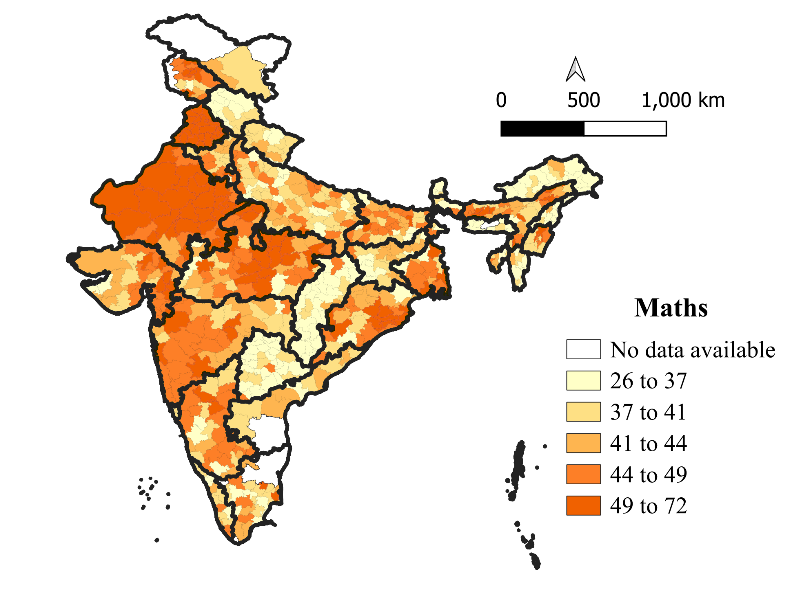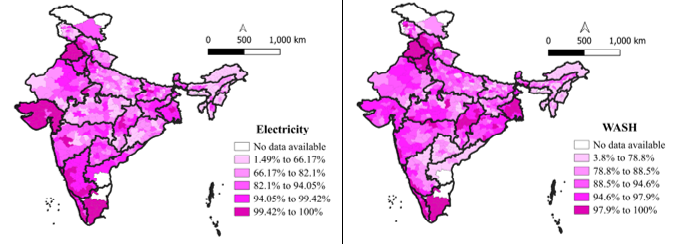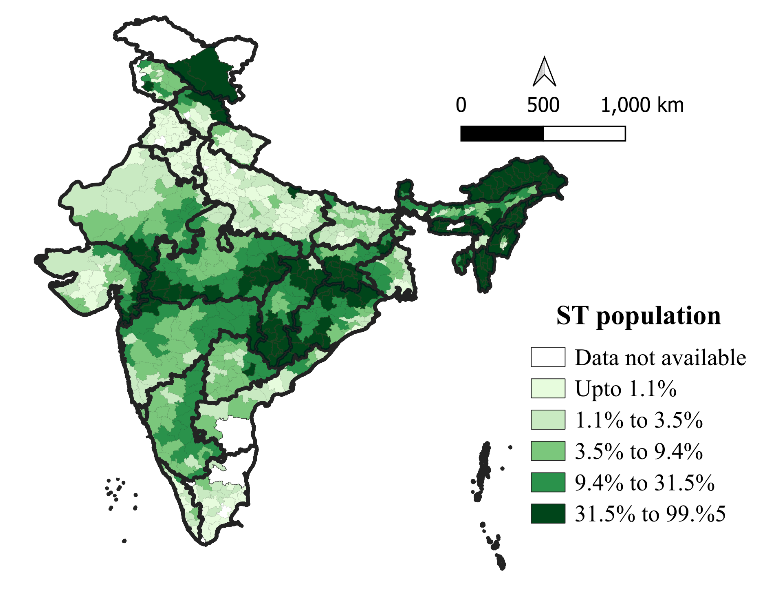The recent National Achievement Survey shows that tribal districts lag behind in learning outcomes. This article suggests this to be of significant concern, as the distribution of schooling infrastructure does not show similar differences. It highlights the below average language and mathematics outcomes in areas with a higher share of tribal populations. It emphasises the need to focus on teachers’ involvement and pedagogical improvements, in addition to investment in physical infrastructure, to achieve the goal of inclusive learning.
India’s achievement of universal school enrollment conceals the regional disparity in learning. While the New Education Policy (2020) and the recent G-20 declaration of delivering quality education emphasise India’s commitment to ‘inclusive and equitable learning’, the current regional distribution of educational outcomes is far from equitable. For many decades, tribal districts have been largely neglected and are experiencing learning distress. This disparity is of significant concern, as the distribution of schooling infrastructure does not show similar stark differences. In this article, we argue that emphasising investment in physical infrastructure while ignoring teachers’ involvement and pedagogical changes is detrimental for the goal of inclusive learning.
State of learning in tribal areas
As per the recent National Family Health Survey (NFHS) 2019-21, the share of Scheduled Tribes (ST) in the total population is 16.74%. An analysis of the educational performance of school-going children based on the National Achievement Survey (NAS) 2021 underlines the below-average performance of tribal children at the primary and middle levels of schooling. For instance, ST students from standard 5 scored 53% on language and 41% on mathematics tests, whereas the corresponding national averages are 55 and 44%. However, such a broad comparison across social groups does not bring out the systematic neglect of learning outcomes in tribal districts. Rather, it is the district-level report cards which show wide regional variation in the percentage of correct answers on these tests.
Figure 1 clearly brings out the clustering of lower learning outcomes for standard 5 students in the tribal districts of India (shown in dark green in Figure 2). Many districts of Meghalaya, Chhattisgarh, Jharkhand, Telangana, Arunachal Pradesh, Mizoram, Ladakh and Himachal Pradesh – districts which have considerably higher shares of ST populations – perform poorly on language and mathematics tests. For instance, districts of Chhattisgarh, Jharkhand and north-eastern states with ST population greater than 50%perform poorly on learning, especially math tests. A similar pattern is also visible in the northern parts of Himachal Pradesh and Ladakh.
Figure 1. District-level average percentage scores of students from standard 5 on language and math tests (in 2021)

Source: Maps generated by authors using NAS 2021 data. ![]()
Figure 2. District-level proportion of ST population
At the same time, districts with a large ST population in Gujarat, Maharashtra, Madhya Pradesh, and Rajasthan show a mixed pattern. Tribal districts of Alirajpur and Jhabua, on the western border of Madhya Pradesh, perform poorly on the learning tests. Both of these districts have a tribal population of more than 80%. However, Nandurbar (in Maharashtra), with an ST population of 69.2%, performs above average on both language and math tests.
Another finding from this analysis is the differences in regional inequality for language and math. The tribal regions are lagging behind others in math learning, but not so much for languages. If we consider the worst performers on math tests for standard 5: 8 out of 10 of the bottom districts are predominantly tribal, with an ST population of more than 60%. Most of these districts belong to Chhattisgarh and Meghalaya. However, only three districts with an ST population of more than 60% appear in the bottom ten performers for languages.
Availability of school infrastructure in tribal areas
The availability of basic infrastructure in schools is a prerequisite to facilitate the teaching-learning process. This suggests that districts with fewer infrastructural facilities such as electricity and WASH (water, sanitation and hygiene) ought to exhibit poor learning performance. Figure 3 depicts the proportion of schools with electricity and WASH facilities. – for instance, only 22.03% of schools in Kandamahal (Odisha), 23.03% in Dhalai (Tripura) and 27.96% in West Karbi Anglong (Assam) have electricity.
Figure 3. District-level share of primary schools with electricity and WASH facilities (in 2020-21)

Source: Maps generated by authors using the Unified District Information System for Education (UDISE) 2020-21 data.
Similarly, not even 30% of schools in most of the districts in Meghalaya, Arunachal Pradesh, and Nagaland have WASH facilities. The poor performance of the north-eastern states on language and math tests goes hand in hand with a lack of infrastructure. At the same time, although electricity and WASH facilities are available in many tribal districts of Jharkhand, Chhattisgarh, Telangana and Orissa, this access to infrastructure is yet to translate into better learning outcomes.
Key takeaways
These findings suggest that increased provision of infrastructure facilities in schools is necessary, yet not sufficient to improve the learning outcomes of children in these tribal regions. The effectiveness of school inputs to influence learning levels depends on the utilisation of these facilities and the organisation of the teaching-learning process (Glewwe and Muralidharan 2016). Thus, one of the most important aspects requiring attention is pedagogy. For instance, teachers need to capture the attention of students by making classroom teaching interesting as well as interactive, which can be done through the use of visual aids, games and real-world applications. Teachers also need to cater to the diverse learning styles and needs of students.
States can implement focused interventions such as the "Teaching at the Right Level" approach developed by Pratham, which is an effective and low-cost strategy to improve learning levels in a short period of time. Additionally, with teachers and the school system at the center, community engagement in child’s learning through digital and alternative means can also facilitate learning achievement (Government of Odisha and ASER Centre, 2022).
As pointed out before, notably, the learning levels of the tribal belts of Madhya Pradesh and Rajasthan are relatively better than others. Targeted educational policies for marginalised sections of society in these two states, such as the Education Guarantee Scheme (EGS), 1997 in Madhya Pradesh, and the Shiksha Karmi Project, 1987 in Rajasthan to improve access to education and school attendance of marginalised students, especially girls, are the likely contributing factors behind this better educational performance (Dreze and Sen 2002, Ramachandran and Sethi 2001). Thus, taking cues from such policy successes and formulating localised policies in tribal areas will help mitigate prevailing regional imbalances.
Views expressed by the authors are personal.
Further Reading
- Dreze, J and A Sen (2002), India: Development and Participation, Oxford University Press.
- Glewwe, P. and K. Muralidharan (2016), “Improving Education Outcomes in Developing Countries: Evidence, Knowledge Gaps, and Policy Implications, Handbook of the Economics of Education, 5: 653-743.
- Government of Odisha and ASER Centre (2022), ‘Impact of Pandemic on School Dropouts among Tribal Children in Odisha and Way Forward’, Report.
- Ramachandran, V and H Sethi (2001), ‘Rajasthan Shiksha Karmi Project: An Overall Appraisal’, Desk study commissioned by Sida, Emassy of Sweden, New Dehli, New Education Division Documents No. 7.




 01 December, 2023
01 December, 2023 






Comments will be held for moderation. Your contact information will not be made public.